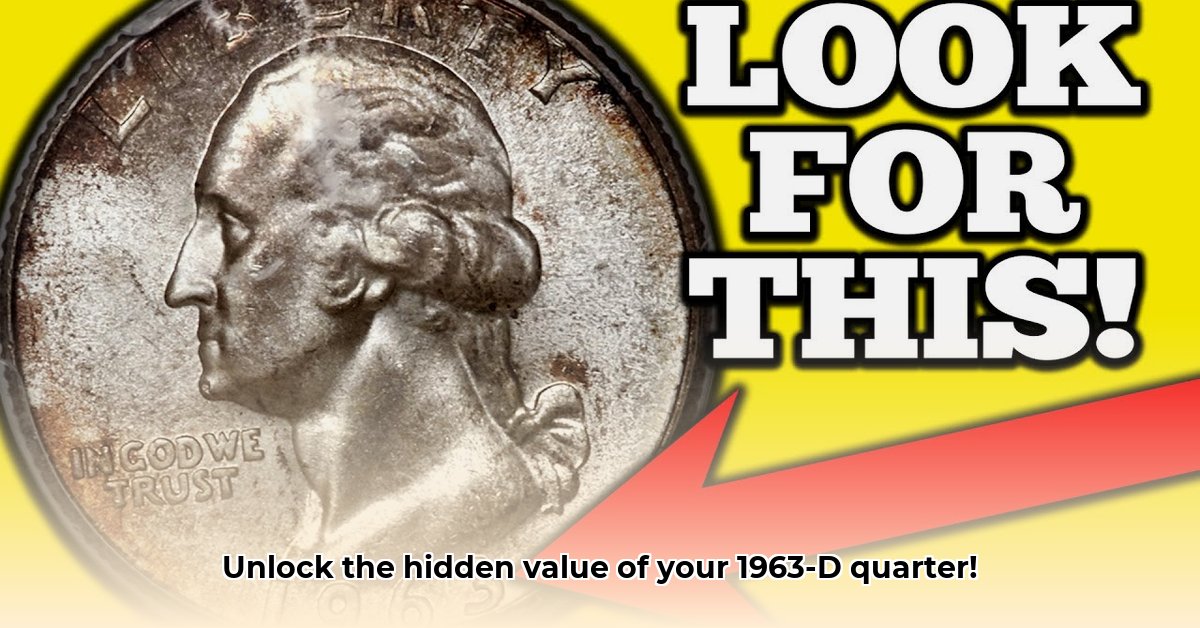
Ever wondered about the true worth of your 1963-D quarter? This guide provides a comprehensive approach to assessing its value, covering condition, grading, and market factors. We'll equip you for confidently determining your coin's worth, whether it's in pristine condition or shows some wear. Let's explore the fascinating world of numismatics and uncover the potential hidden in your pocket change. For more on rare coin values, check out this helpful resource on 1845 dollar coins.
Understanding the Grade: Condition is King
A coin's condition drastically impacts its value. Numismatists (coin experts) use a grading scale, typically ranging from "Poor" to "Mint State" (MS or Uncirculated), to describe a coin's condition. Think of it like a used car – a pristine vehicle fetches a much higher price than a rusty one. The higher the grade, the greater the value.
Is your 1963-D quarter's value a mystery? A thorough understanding of grading is your key to unlocking its true worth.
The following table presents approximate value ranges. Remember, actual value fluctuates with market conditions and specific coin characteristics.
| Grade | Description | Approximate Value Range (USD) | Notes |
|---|---|---|---|
| Poor | Seriously worn; details barely visible | $1 - $3 | Features are largely indistinguishable. |
| Fair | Worn, but key features recognizable | $3 - $5 | Significant wear is apparent. |
| Good | Most of the design is visible | $5 - $10 | Moderate wear is present. |
| Very Good | Shows some wear, but details are sharp | $10 - $20 | Light wear is visible, details remain clear. |
| Fine | Clear details, but some wear is present | $20 - $40 | More wear than Very Good, but many details are still crisp. |
| Very Fine | Minor wear; most details are sharp and defined | $40 - $80 | Minimal wear; coin appears quite nice. |
| Extremely Fine | Very little wear; details are sharp | $80 - $150 | Sharp details, minor handling signs only. |
| About Uncirculated (AU) | Few signs of circulation; near perfect | $150 - $300 | Hardly any wear; appears almost brand new. |
| Mint State (MS) | Uncirculated; flawless condition | $300+ | Perfect condition; highly sought-after by collectors. |
Did you know that millions of 1963 Washington quarters were minted? However, the Denver mint mark ("D") makes your coin slightly rarer, potentially boosting its value.
The "D" Mint Mark: A Significance Boost
The "D" mint mark signifies your quarter was struck at the Denver Mint. While millions of 1963 Washington quarters were produced (over 135 million!), the Denver-minted versions are relatively scarcer than their Philadelphia counterparts (which lack a mint mark). This added rarity typically translates to a higher value, especially for coins in excellent condition.
Beyond Grade: Factors Affecting Value
Even with identical grades, two 1963-D quarters can vary in value due to several factors:
Toning: Natural discoloration that develops over time. Certain toning patterns are highly desirable and can significantly increase a coin's value.
Luster: The coin's shine. A bright, original luster enhances its visual appeal and value.
Surface Imperfections: Scratches, nicks, and blemishes reduce a coin's value.
Accurate Valuation and Selling Your Coin
For the most accurate valuation, consult multiple resources: reputable online marketplaces (like eBay and Heritage Auctions), local coin dealers, and professional grading services (PCGS or NGC). These services provide expert assessments and certification, enhancing a coin's credibility and marketability.
Selling through established channels safeguards against scams and ensures a fair price. Always compare prices from various sources before committing to a sale.
This guide provides a solid foundation for evaluating your 1963-D quarter's worth. Remember, the numismatic market is dynamic, and continuous learning enhances your expertise.
How to Accurately Grade Your 1963-D Quarter
Key Takeaways:
- Accurate grading is crucial for determining the precise value of your 1963-D quarter.
- The Sheldon Scale is the industry standard for grading coins, ranging from Poor (1) to Mint State-70 (MS-70).
- Mint State grades represent uncirculated coins, while lower grades show varying levels of wear.
Mastering Visual Inspection
Begin with a thorough visual inspection under good lighting. Examine for: scratches, dents, marks, luster (shine), and toning (color changes). Remember, a brilliant surface and even toning are usually positive indicators.
Step-by-Step Grading Process
Surface Examination: Look for imperfections. A smooth surface suggests a higher grade.
Luster Assessment: Check the coin's shine. Brilliant luster indicates a better-preserved coin.
Strike Evaluation: Assess the sharpness of details. A full strike points towards a higher grade coin.
Toning Observation: Note any color changes. Attractive toning can enhance value.
Mint Marks and Error Detection
Carefully examine the "D" mint mark for clarity. A faint mark suggests potential issues. Furthermore, look for any minting errors (e.g., doubled dies). These can dramatically increase a coin's value, often requiring expert identification.
Determining the Value: A Final Price Estimation
After assigning a grade, consult price guides, online marketplaces, and auction results for a realistic value. Remember, market demands and silver prices play a crucial role; values are not static.
Pricing Considerations: A Summary
| Grade | Approximate Value Range (USD) | Notes |
|---|---|---|
| MS-60 | $5 - $15 | Minimal wear, possible surface imperfections. |
| MS-65 | $20 - $50 | Lightly circulated, very good condition |
| MS-68 | $75 - $200 | Uncirculated condition, very few flaws |
| MS-70 | $200+ | Gem condition, flawless |
| Error Coins | Highly variable | Value depends heavily on the type and rarity of the error. |
Note: These values are estimates and are subject to market fluctuations.